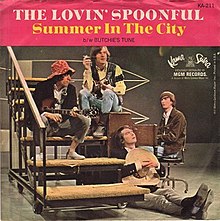
Back Summer in the City Bulgarian Summer in the City Danish Summer in the City (Lied) German Summer in the City Finnish Summer in the City (chanson) French Summer in the City Italian サマー・イン・ザ・シティ Japanese Summer in the City (lied) Dutch Summer in the City NN Summer in the City Russian
| "Summer in the City" | ||||
|---|---|---|---|---|
 U.S. picture sleeve | ||||
| Single by the Lovin' Spoonful | ||||
| B-side |
| |||
| Released | July 4, 1966 | |||
| Recorded | March 1966 | |||
| Studio | Columbia 7th Avenue, New York City | |||
| Genre | ||||
| Length | 2:39 | |||
| Label | Kama Sutra | |||
| Songwriter(s) | John Sebastian, Mark Sebastian, Steve Boone | |||
| Producer(s) | Erik Jacobsen | |||
| The Lovin' Spoonful U.S. singles chronology | ||||
| ||||
| The Lovin' Spoonful U.K. singles chronology | ||||
| ||||
| Licensed audio | ||||
| "Summer in the City" on YouTube | ||||
"Summer in the City" is a song by the American folk-rock band the Lovin' Spoonful. Written by John Sebastian, Mark Sebastian and Steve Boone, the song was released as a non-album single in July 1966 and was included on the album Hums of the Lovin' Spoonful later that year. The single was the Lovin' Spoonful's fifth to break the top ten in the United States, and the only one by the group to reach number one. A departure from the band's lighter sound, the recording features a harder rock style. The lyrics differ from most songs about the summer by lamenting the heat, contrasting the unpleasant warmth and noise of the daytime with the relief offered by the cool night, which allows for the nightlife to begin.
John Sebastian reworked the lyrics and melody of "Summer in the City" from a song written by his teenage brother Mark. Boone contributed the song's bridge while in the studio. The Lovin' Spoonful recorded "Summer in the City" in two sessions at Columbia Records' 7th Avenue Studio in New York in March 1966. Erik Jacobsen produced the sessions with assistance from engineer Roy Halee, while Artie Schroeck performed as a session musician on a Wurlitzer electric piano. The recording is an early instance in pop music of added sound effects, made up of car horns and a pneumatic drill to mimic city noises.
"Summer in the City" has since received praise from several music critics and musicologists for its changing major-minor keys and its inventive use of sound effects. The song has been covered by several artists, including Quincy Jones, whose 1973 version won the Grammy Award for Best Instrumental Arrangement and has since been sampled by numerous hip hop artists.
- ^ MacDonald 2007, p. 202n3; Turner 2016, p. 293; Perone 2018, pp. 115, 119; Zimmerman & Zimmerman 2004, p. 119.
- ^ Santelli 1985, p. 177.
- ^ Cite error: The named reference
Unterbergerwas invoked but never defined (see the help page). - ^ Unterberger 2002, p. 212.
- ^ Matijas-Mecca 2020, p. 112.
© MMXXIII Rich X Search. We shall prevail. All rights reserved. Rich X Search